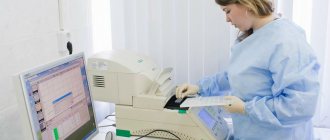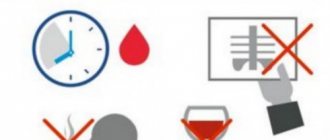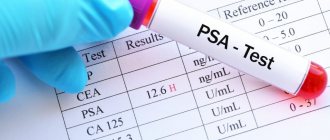Herpes
Syphilis
HIV
36732 11 August
IMPORTANT!
The information in this section cannot be used for self-diagnosis and self-treatment.
In case of pain or other exacerbation of the disease, diagnostic tests should be prescribed only by the attending physician. To make a diagnosis and properly prescribe treatment, you should contact your doctor. We remind you that independent interpretation of the results is unacceptable; the information below is for reference only.
Antibodies to HIV-1/2 and HIV-1/2 antigen (HIV Ag/Ab Combo): indications for use, rules for preparing for the test, interpretation of results and normal indicators. HIV infection
is an infectious disease that develops as a result of many years of persistence (constant residence) in lymphocytes, macrophages and cells of the nervous tissue of the human immunodeficiency virus (hereinafter referred to as HIV), characterized by a slowly progressive defect of the immune system, which leads to the death of the patient from secondary lesions described as acquired immunodeficiency syndrome (hereinafter referred to as AIDS).
To date, 4 varieties of this virus have been registered, which differ in the structure of their shell. Human immunodeficiency viruses types 1 and 2 are considered clinically significant (the most common).
HIV (Human Immunodeficiency Virus) is a virus belonging to the retrovirus family (a family of RNA viruses that primarily infect vertebrates) that infects cells of the human immune system. After a few weeks of infection, antibodies to HIV begin to be produced.
If the result is positive
A positive result means that the test system detected antibodies to HIV in the blood sample, which may indicate that you actually have HIV infection. A positive result in ELISA must be confirmed in an immunoblot with the same blood sample. In rare cases, the result is false positive. False-positive results occur with viral infections in pregnant women, and with autoimmune diseases. A positive result may also be referred to as seropositive or HIV+ status.
General blood test indicators for HIV
In the early stages of infection, the indicators of a general blood test change little or even remain within the normal range.
An attentive physician can associate some marginal fluctuations in leukocytes (white blood count) with episodes of repeated recurrent colds and respiratory infections.
In more advanced stages of the disease, when the body’s compensatory capabilities weaken, the following changes occur in the CBC:
- Anemia. A decrease in the number of red blood cells below the age and gender norm is associated with HIV damage to bone marrow cells and general exhaustion of the body. The degree of anemia correlates with the activity of HIV infection: anemia increases with the progression of the disease and, conversely, recedes during ART therapy.
- Leukopenia and lymphopenia are typical phenomena for HIV. A general blood test can detect a persistent decrease in the number of leukocytes (below 4*10 to the 9th degree) and lymphocytes (below 13%), the indicators of these cells help doctors make a preliminary prognosis and develop measures to protect a person from other infections (for example, prescribe biseptol prophylaxis ).
- Thrombocytopenia. A drop in platelet levels below normal (180*10 to the 9th power) is very typical for HIV infection; within 10 years, this phenomenon occurs in 45% of infected people. Thrombocytopenia is caused by two mechanisms: autoimmune damage to thrombocytopenia and a decrease in the number of their precursors (megakaryocytes).
It is very important for the patient to comply with the deadlines when the doctor recommends taking the OAC.
This will help you notice dangerous complications of HIV infection in time and prevent them.
In addition, we must not forget about the risk of developing adverse reactions in response to pre-drug ART therapy.
If the result is doubtful
Quite rarely, test results are questionable. This can happen in two cases: when a person has recently become infected with HIV and the concentration of antibodies is insufficient for detection by conventional test systems, or when HIV is absent, but there are other chronic diseases - metabolic or autoimmune in nature. Therefore, testing immediately after exposure is inappropriate. If a questionable result was obtained during examination using the enzyme immunoassay method, a confirmatory analysis is usually performed using an immunoblot. If the questionable result remains, the examination is repeated after 1-3 months and the patient is observed for six months.
ESR indicator
A very important data from the CBC is the erythrocyte sedimentation rate, or ESR for short.
The norm is 4-10 mm per hour.
When the ESR accelerates, this indicates an imbalance in the protein balance of the blood.
Unfortunately, the indicator is completely nonspecific: ESR increases with any infection, injury, or oncology.
Patients are characterized by such a combination when the erythrocyte sedimentation rate is increased to 30-40-50 mm per hour.
And the person feels more or less normal.
This picture is associated with a decrease in the number of white blood cells.
In particular, those lymphocytes that synthesize immunoglobulin proteins.
A decrease in the amount of these immune proteins entails a relative increase in albumin proteins, which is reflected in the increase in ESR.
When do you need to take an AT and AG test for HIV 1/2 (screening, quality)?
1. Enlarged lymph nodes in more than two areas; 2. Leukopenia with lymphopenia; 3. Night sweats; 4. Sudden weight loss of unknown cause; 5. Diarrhea for more than three weeks of unknown cause; 6. Fever of unknown cause; 7. Planning pregnancy; 8. Preoperative preparation, hospitalization; 9. Identification of the following infections or combinations thereof: tuberculosis, manifest toxoplasmosis, often recurrent herpesvirus infection, candidiasis of internal organs, repeated herpes zoster neuralgia caused by mycoplasmas, pneumocystis or legionella pneumonia; 10. Kaposi's sarcoma at a young age; 11. Casual sex.
Indications for use
Indications for the purpose of analysis:
- Any contact with biological fluids (blood, semen) of a person infected with HIV.
- Pregnancy (including planned), planned admission to the maternity hospital.
- Preparation for surgery and planned admission to the hospital.
- Desire to become a donor.
- Unprotected sexual intercourse.
- If a sexually transmitted infection is detected.
- If you are unsure about the sterility of the needles used for tattooing or piercing.
- If you have a past/present drug addiction.
- During sexual contact with a person who has HIV.
- In the maternity hospital for a newborn baby.
- With long-term persistence of symptoms such as malaise, elevated body temperature, weight loss, ulcers of the oral mucosa, allergies, the causes of which are not identified by hemotests, susceptibility to rare infections, candidiasis, frequent infectious diseases.
Where and how can you get diagnosed with HIV?
Today, testing for HIV infection is not a problem. If the patient wishes, blood can be donated for analysis anonymously and absolutely free. This can be done in medical organizations at your place of residence, in the Sverdlovsk Regional Center for the Prevention and Control of AIDS (Ekaterinburg, Yasnaya St., 46. Registration: (343) 383-30-18 Helpline on HIV/AIDS (weekdays, from 9 to 20 hours).
Diagnosis of HIV is purely voluntary. However, there are four situations for which taking the test is mandatory:
- Donation.
- Employment in a job that involves direct contact with biological material that may contain HIV.
- Foreign citizens.
Persons conscripted for military service who enter military educational institutions.
But even in these cases, testing cannot be carried out forcibly, since any medical intervention requires the voluntary and informed consent of the patient. It is a conscious one, since each of us must understand the importance of timely diagnosis of HIV.
Decoding HIV test results
Given that viral load can rise and fall naturally, viral load is not assessed separately from CD4 count. In other words, if the CD4 count is normal, but the viral load has increased, then this is not a cause for concern. Conversely, if the viral load increases against the background of a decrease in CD4 levels, then “it’s time to sound the alarm.”
The results obtained during the viral load study are interpreted as follows.
- Up to 10,000 copies of the virus – low viral load.
- Over 100,000 copies – high viral load.
- 0 copies – there is no virus in the body, which is considered the norm for a healthy person and indicates the need for repeated testing for HIV-infected patients.
Undetectable viral load is the minimum number of copies, the presence of which cannot be detected using the selected research method.
Thus, an undetectable viral load is the goal that all HIV-infected patients strive for. This result indicates that there is a virus in the body, but its amount is negligible and at the moment the person is not in danger. In this case, it is imperative to assess the general condition of the immune system. To do this, you need to determine the number of CD4+ antigens of T-lymphocytes. Cell norms and possible deviations are shown in the table below.
| CD4 count | Possible patient actions |
| 1500 – 500 cells/ml | norm |
| 500 – 350 cells/ml | need to start HAART |
| 200 cells/ml and below | administer HAART |
| Less than 100 cells/ml | carry out HAART and symptomatic therapy |
By assessing viral load and CD4 levels, a reliable conclusion can be made about the patient’s health status. If the viral load is low, for example, 4000 copies and CD4 counts are normal, then HAART is effective. And vice versa - a high viral load with a decrease in CD4 counts indicates low effectiveness of treatment.
Timeframe for analysis
The timing of the analysis may vary. In government institutions, the duration of the procedure can be up to several weeks, after which the patient is informed about the result by telephone. In specialized centers and private laboratories it is possible to get an answer within 1–2 days. The results are given out in person, after providing a document or number (when conducting an anonymous study).
AIDS is a dangerous progressive disease caused by the human immunodeficiency virus. For a long time it is asymptomatic, so it is important to regularly donate blood for testing. What indicators are taken into account when making a diagnosis, how to conduct a study correctly, how to avoid false results - all these questions can be asked to a laboratory employee when submitting the material. The main thing is to come for the procedure in the first half of the day, in the morning and the day before giving up fatty and heavy foods and drinks.
Study of specific antibodies and p24 antigen of the human immunodeficiency virus.
Synonyms Russian
Antibodies to HIV 1, 2, antibodies to human immunodeficiency virus, HIV-1 p24, HIV-1 antigen, p24 antigen.
English synonyms
Anti-HIV, HIV antibodies, human immunodeficiency virus antibodies, HIV-1 p24, HIV-1 Ag, p24-antigen.
Research method
Electrochemiluminescent immunoassay (ECLIA).
What biomaterial can be used for research?
Venous blood.
How to properly prepare for research?
- Testing for HIV infection can be carried out anonymously and confidentially. During a confidential examination, it is mandatory to present a passport.
- Do not smoke for 30 minutes before the test.
General information about the study
HIV (human immunodeficiency virus) is a virus of the retrovirus family that infects cells of the human immune system (CD4, T helper cells). Causes AIDS.
HIV-1 is the most common type of virus, most often found in Russia, the USA, Europe, Japan and Australia (usually subtype B).
HIV-2 is a rare type, common in West Africa.
To diagnose the human immunodeficiency virus, a fourth-generation combined test system is used, which is capable of detecting HIV infection within 2 weeks after the virus enters the blood, while first-generation test systems do this only 6-12 weeks after infection.
The advantage of this combined HIV test is the detection, thanks to the use of antibodies to HIV-1 p24 as reagents, of the specific p24 antigen (viral capsid protein), which can be detected by this test within 1-4 weeks from the moment of infection, i.e. even before seroconversion, which significantly shortens the “window period”.
In addition, this HIV test detects antibodies to HIV-1 and HIV-2 in the blood (using the antigen-antibody reaction), which are produced in sufficient quantities to be detected by the test system 2-8 weeks after infection.
After seroconversion, antibodies begin to bind to the p24 antigen, resulting in a positive HIV antibody test and a negative p24 test. However, after some time, both antibodies and antigen will be detected in the blood at the same time. At the terminal stage, an AIDS test for antibodies to HIV may give a negative result, since the mechanism of antibody production is disrupted.
Stages of HIV infection
- The incubation period, or “seronegative window period,” is the time from the moment of infection until the development of protective antibodies to the virus in the blood, when tests for antibodies to HIV are negative, but the person can already transmit the virus to other people. The duration of this period is from 2 weeks to 6 months.
- The period of acute HIV infection begins on average 2-4 weeks from the moment of infection and lasts approximately 2-3 weeks. At this stage, some people may develop nonspecific flu-like symptoms due to active replication of the virus.
- The latent stage is asymptomatic, but during it there is a gradual decrease in immunity and an increase in the amount of virus in the blood.
- AIDS (acquired immunodeficiency syndrome) is the final stage of development of HIV infection, which is characterized by severe suppression of the immune system, as well as concomitant diseases, encephalopathy or cancer.
Despite the fact that HIV infection is incurable, today there is highly active antiretroviral therapy (ART), which can significantly prolong the life of an HIV-infected person and improve its quality.
This test has a particularly high diagnostic value if HIV infection occurred shortly before the time of testing (2-4 weeks).
What is the research used for?
The analysis is used for early diagnosis of HIV, which allows preventing further transmission of the virus to other people, as well as timely initiation of antiretroviral therapy and treatment of diseases that contribute to the progression of HIV infection.
When is the study scheduled?
- With persistent symptoms (for 2-3 weeks) of unknown etiology: low-grade fever, diarrhea, night sweats, sudden weight loss, enlarged lymph nodes.
- For recurrent herpes infection, viral hepatitis, pneumonia, tuberculosis, toxoplasmosis.
- If the patient suffers from sexually transmitted diseases (syphilis, chlamydia, gonorrhea, genital herpes, bacterial vaginosis).
- If the patient has had unprotected vaginal, anal or oral sex with multiple sexual partners, a new partner, or a partner whose HIV status the patient is not sure of.
- When the patient underwent a donor blood transfusion (although cases of infection in this way are practically excluded, since the blood is carefully tested for the presence of viral particles and is subjected to special heat treatment).
- If the patient injected drugs using unsterile instruments.
- During pregnancy/planning pregnancy (taking azidothymidine during pregnancy, caesarean section to avoid transmission of the virus to the baby during passage through the birth canal, and avoiding breastfeeding reduces the risk of mother-to-child transmission of HIV from 30% to 1%).
- Accidental injection with a syringe or other object (for example, a medical instrument) containing infected blood (in such cases the likelihood of infection is extremely low).
What do the results mean?
Reference values
Result: negative.
Reasons for negative results:
- absence of HIV infection,
- the period of the seronegative window (neither the antigen nor the antibodies have yet been developed in sufficient quantities necessary for detection by the test system).
Reasons for the positive result:
- HIV infection.
Preparation
The reliability and accuracy of the study indicators largely depend on the correct preparation of the patient for its conduct. When being tested for HIV, a patient must:
- take the test on an empty stomach; food intake must be stopped at least 4-5 hours before donating blood (otherwise changes in biochemical parameters may cause a false deviation from the norm);
- abstain from alcohol (3 days in advance), smoking (1 hour in advance);
- physical overload on the eve of the analysis should be limited.
Complexes with this research
Entry into IVF Examination when a woman enters the IVF procedure 15,090 ₽ Composition
Preparation for partner childbirth for a man Tests necessary to accompany a woman in labor 2,250 ₽ Composition
Hospital complex Infectious screening for prevention and hospitalization 1,170 ₽ Composition
IN OTHER COMPLEXES
- Men's check-up No. 1 RUB 10,960
- Male infertility. Extended examination 18,900 ₽
- Expanded hospital complex RUB 4,390
- Pregnancy planning. Diagnosis of infections RUB 5,720
- Examination during pregnancy. 1st trimester 10,260 RUR







